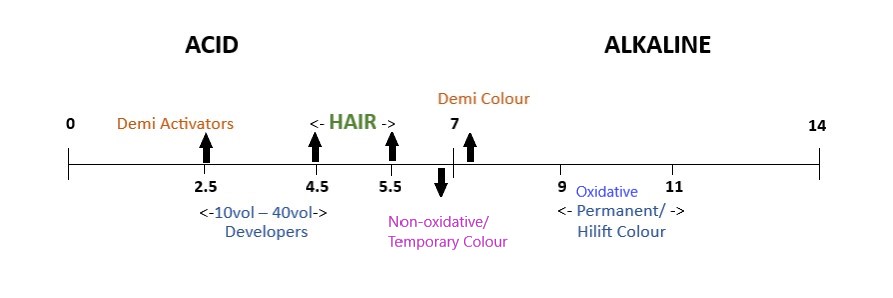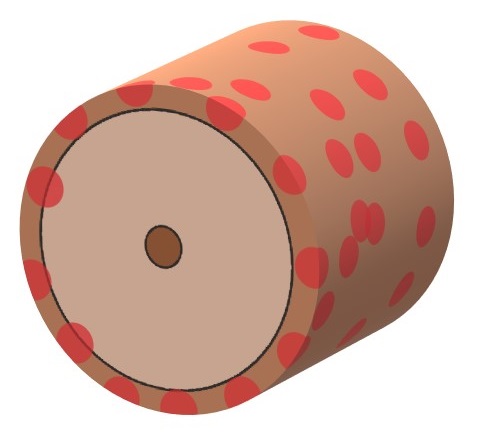Chapter 1 – Back to the Basics
1.3 How Does Hair Colour Work?
Let’s have a closer look at how hair colouring products work, and how they affect the hair strand. This section will serve as a quick review of pH levels, non-oxidative colour, and oxidative colour.
pH Levels
pH scale is a scale from 0 to 14 that is used to determine the acidity or alkalinity of various substances. This scale is very important when colouring hair.

As you will have learned in your Hairstylist Foundations, hair has an acid pH of 4.5–5.5. Anytime a colouring product with a pH higher than 5.5 is applied to the hair, it will soften the cuticle and swell the hair strand, allowing the colour to penetrate.
Oxidative Colours
Hydrogen peroxide developers and demi activators are themselves acidic, so they require the alkalinity of the colour product itself to swell the hair and penetrate the cuticle. Once this action has occurred, the developer will begin to oxidize the colour inside of the hair strand. To clarify, the alkalinity of the hair colour is what causes the cuticle to swell and the acidity of the hydrogen peroxide (H2O2) is what causes the colour to oxidize. This oxidation turns the colourless molecules into coloured molecules, which explains why colour comes out of the tube white and begins to change colour once mixed with developer in the bowl. This is where the term “oxidative colour” comes from.
Demi-permanent colour resides at a pH of about 6.0–8.0, which will swell the hair strand just enough to penetrate just inside the cuticle layer. Permanent and hi-lift colouring products have a pH between 9.0–11.0 and are alkaline. These alkaline products swell the hair strand further to allow the colour molecules to penetrate through the cuticle layer and into the cortex. The alkaline ingredient in permanent colour is ammonia, or an alternate aniline derivative. Oxidative colour products have a mixture of small and large colour molecules, with the larger sitting near the surface of the cuticle layer and the smaller sitting within the cuticle and cortex layers.

Non-Oxidative Colours
Non-oxidative semi and temporary colouring products generally have an acid pH and therefore do not swell the hair strand as much, which makes them a gentler option. Semi and temporary colours are deposit only and cannot lift hair colour to a lighter level. These products contain large colour molecules which sit on the surface of the cuticle layer.

Once you have a solid understanding of how and why colour works the way it does, you will be better equipped to apply that knowledge to your colour consultations and colour formulations. In Chapter 2: The Consultation, we will review these principles in more depth.
Media Attributions
- All images in this chapter are by A. Magtiza and are under a CC BY 4.0 Licence.
Colouring products that do not require the use or mixing of a developing agent such as hydrogen peroxide.
Colouring products that require a developing agent, such as hydrogen peroxide, to oxidize and introduce colour molecules into the hair strand.
A scale from 0 to 14 that is used to determine the acidity or alkalinity of various substances.
The process in which a developing agent combines with an oxidative colouring product to turn colourless molecules into coloured molecules for the purpose of hair colouring.

